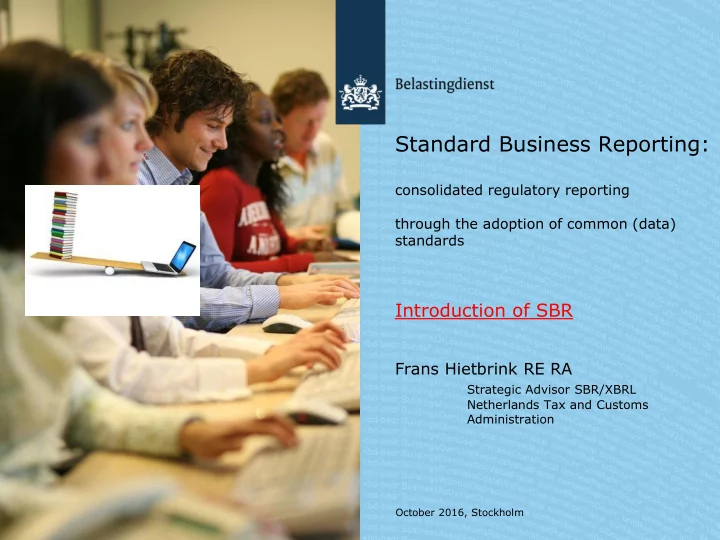

Standard Business Reporting: consolidated regulatory reporting through the adoption of common (data) standards Introduction of SBR Frans Hietbrink RE RA Strategic Advisor SBR/XBRL Netherlands Tax and Customs Administration October 2016, Stockholm
Du vill veta vad mitt jobb är? Tja, jag kan säga att jag jobbar på som affärsrapportering, mjukvaruutveckling, försäkran, bokföring, administration och skatterätt, revision, Public Key Infra, mångsidiga plattformar, XBRL, taxonomier, affärsmodeller, offentlig-privat samverkan ämnen , .... men detta är inte en fullständig lista. Så vad gör man? October 2016, Stockholm
October 2016, Stockholm
SBR program: designed to address a key issue October 2016, Stockholm
Standard Business Reporting: • Governance and Standards are key success factors for SBR • Vision and Goals are key drivers for how to organize Multi Domain Governance Approach Efficiency + Reuse Transparency Process, Data, Standardization Technology October 2016, Stockholm
Benefits of standardisation Network effect: the network is more valuable for every individual when it is bigger Economies of scale: the costs of joining the network decrease October 2016, Stockholm
SBR program: designed to address a key issue Banking Agriculture & Healthcare food Agile Employee minds Benefit Education Public housing Intra- government October 2016, Stockholm
SBR vs. XBRL – key differences Data Technology Processes NT NTA XBRL WUS, etc DigiPoort Public + private (governance) XBRL Arch. Taxo Other Various portals, ports, XBRL, but no pre- countries Different taxonomies, protocols for defined process even within countries submitting messages standards Imposed by individual regulator NT(A) = Netherlands Taxonomy (Architecture) WUS = WSDL/UDDI/SOAP: communication standards October 2016, Stockholm
October 2016, Stockholm
Legislation & Rules Financial Reporting European legislation Tax legislation Definitions GAAP Elements Financial Statistics VAT Reports Statement filing filing Datasets Open Data Open Data October 2016, Stockholm
SBR: Challenges in the Netherlands SBR-NL challenges: • working in a competitive market Phases in the process Optimism • seeking the buy-in of organizations involved (public & private sector) • getting the market to actually start using SBR SBR-NL: seeking co-operation: • on issues that have deep impact for business- and government processes • on issues that were not understood by Pessimism many Agendasetting Uninformed Informed Informed Realisation Ti optimism pessimism optimism • Therefore: Development & Dissemination me of Knowledge is key topic October 2016, Stockholm
SBR: An easy approach? Definitely not Coalition of the willing is never easy • It takes a strong vision and shared purpose to get the right results • The shared purpose drives which stakeholders need to be at the table • Representatives from stakeholders need to be at the right level • How to manage a multi domain program? • Change and investments for many stakeholders need to be • synchronized to be effective Timing is everything : the impact of a filing mandate • October 2016, Stockholm
SBR: Lessons learned Acknowledge the intricate duality between governance and technology • governance should be rigid and flexible: • rigid: to guarantee stability of coöperation and architecture • flexible : to guarantee adaptivity in case of new (different) chains or problems • Recognise that the knowledge and skills required for achieving goals • are multi-disciplinary financial reporting, accountancy, administrative and fiscal law, auditing, credit reporting, • software development, public key infrastructures, XBRL • information processes, taxonomies • public-private partnerships • Do not expect too much too soon • October 2016, Stockholm
SBR: Lessons learned All parties must support the rationale of the (mandatory) program • Joint action. Collectively felt responsibility and profit. • ‘Mandatory’ as a final, but decisive push, ‘if anything else agrees’. • The obligation must have a fit within a total framework of a • customer-oriented treatment. Program Management Office: • Independent from all other parties. • As much as possible. In word and in deed. • Accepted by all other parties on all levels. • Support on strategic level. • High level of quality off staff • Knowledge of data, processes (SBR and chain), communication, policy-making, law, etc. • Endurance. • Flexibility. • October 2016, Stockholm
Recommend
More recommend